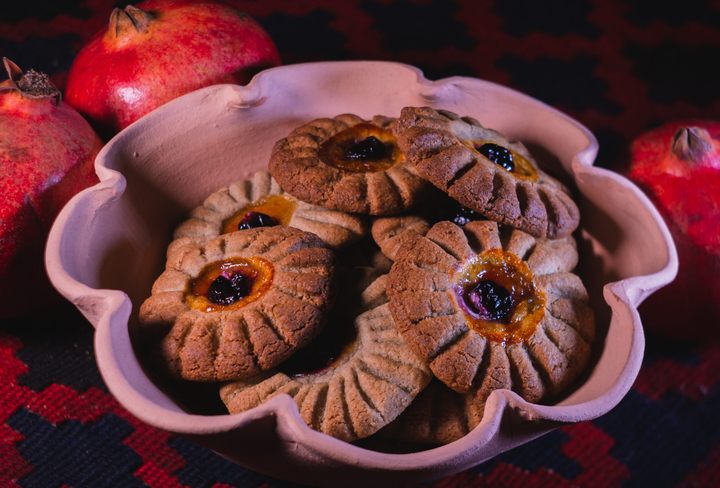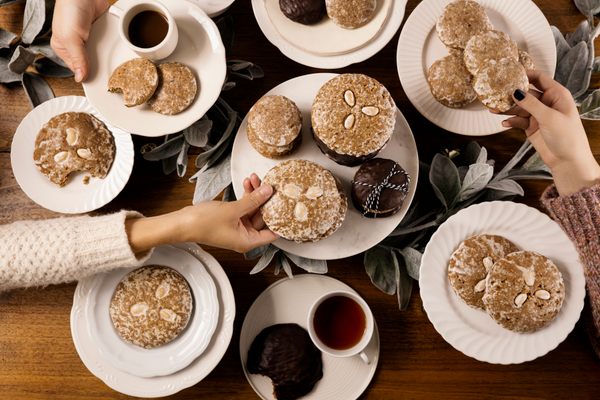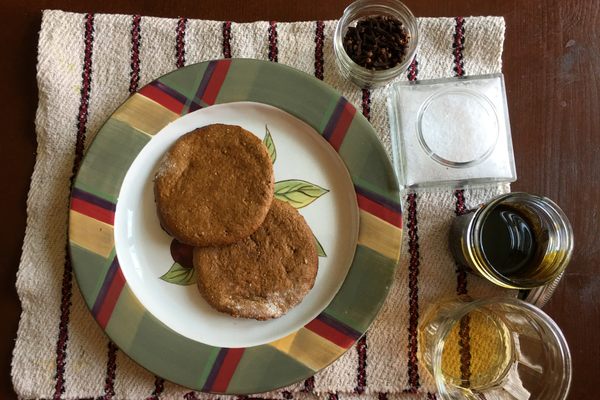

Ancient Cookies, Medieval Mead, and Our Other Favorite Recipe Stories This Year
Bake, brew, and stir-fry your way through history.
No recipe emerges from a vacuum, and uncovering the context behind long-lost dishes is often a delicious way to immerse yourself in other times. Gastro Obscura published dozens of recipes from all over the world this year, each with stories to tell. From unpacking the problematic history of one of Emily Dickinson’s favorite sweets to challenging the narrative surrounding chop suey, our writers and editors never shied away from complicated tales. Many of our top stories centered on recreating delicacies from another time and place, be it Medieval mead from France, a cookie from an ancient Chinese tomb, or a doughnut from a doomed franchise.
The Quest to Recreate a Lost and ‘Terrifying’ Medieval Mead
by Gemma Tarlach
“People who like rollercoasters and jumping off cliffs like bochet,” says scholar Susan Verberg. That’s because this long-lost Medieval mead requires nerves of steel and a devil-may-care attitude when it comes to second-degree burns. Unlike modern meads, this 14th-century French specialty requires standing over a “sugar volcano” (a cauldron of boiling honey). Although the meads made for this story need to age some more in order to reach their full potential, initial tastes revealed flavors of “caramel, honey, and history.”

Resurrecting the Spudnut, America’s Forgotten Halloween Treat
by Diana Hubbell
When Krispy Kreme and Dunkin’ Donuts were still gaining momentum, one fried-dough franchise ruled the United States: Spudnuts. Launched by the Pelton brothers in Utah in 1940, the chain once had hundreds of outlets stretching across the nation and as far as Japan. Potatoes were the not-so-secret ingredient that gave these yeasted fritters their tender crumb. The doughnuts were an American staple and Halloween tradition for decades—until all of a sudden, they weren’t. The collapse of Spudnuts is a tale of corporate greed, enterprising con men, and bitter legal battles. While the formula for the original Spudnuts remains a tightly guarded secret, Gastro Obscura uncovered a few key details for home cooks looking to fry their own.
The Historic Russian Recipe That Turns Apples Into Marshmallows
by Anne Ewbank
What did Tolstoy, Dostoevsky, and Catherine the Great all love? Prior to the Russian Revolution, pastila was an essential component of any grand soirée. The ingredient list is deceptively short: apples, sugar, and egg whites. Vigorous beating and a stint in the oven transforms these ingredients into a caramelized marshmallowy confection with an intense apple flavor. Under the Bolsheviks, the labor-intensive dessert all but disappeared, replaced by more utilitarian survival foods. Nowadays, the invention of stand mixers means that you no longer need hours and bulging biceps to enjoy this sweet treat.
The Hidden, Magnificent History of Chop Suey
by Miranda Brown
The history of Chinese-American cuisine’s best-known dish is fraught with misunderstanding and slander. According to some myths, the term “chop suey” referred to a dish thrown together with “odds and ends” or even “garbage.” The truth is that this much-maligned dish has its roots in royalty, with its historic predecessors earning places of honor at Imperial banquets in the Qing dynasty. Modern-day gourmands hoping to dine like an emperor can try their hand at whipping up this sophisticated recipe made with lamb shoulder and heart.

The Enduring Midwestern Mystery of Blue Moon Ice Cream
by Luke Fater
“I have the formula here in front of me, but I’m not gonna tell you what’s in it,” says James Doig, vice president of Weber Flavors. So begins Fater’s quest to unravel the complex—and top secret—flavor profile behind this electric-blue ice cream parlor classic. Spoiler alert: The corporate guardians of the formula never crack, but by consulting flavor experts and Blue Moon aficionados, Fater comes up with a homemade homage that captures a bit of that elusive magic.
How to Recreate 1,300-Year-Old Cookies
by Anne Ewbank
When a British-Hungarian archeologist unearthed a tomb in 1915 in Xinjiang, China, he uncovered something truly unexpected: pastries. These petal-shaped cookies may have been around for more than a millennium, but they look remarkably similar to something one might find at a present-day bakeshop. Eran ud Turan, a living history group, sought to recreate the recipe for these jammy treats.
It Takes a Village to Feed Cambodia’s Ravenous Ghosts
by Diana Hubbell
“I believe that Cambodia has a lot more to tell beyond the killing fields and our temples,” says Rotanak Ros. Chef Nak, as her followers call her, has dedicated her life to tracking down survivors of the Khmer Rouge and recording their recipes before this piece of intangible heritage is lost forever. During Pchum Ben, the Khmer Festival of the Ancestors, Ros spoke about honoring the ghosts of Cambodia’s past through ritual and remembrance. She also shares a traditional recipe num ansom chrouk, the savory, steamed rice cakes that serve as a feast for both the living and the dead.

Eat Like a Medieval Saint With Her Recipe for ‘Cookies of Joy’
by Sam O’Brien
Hildegard of Bingen was a petite, 12th-century nun with a towering influence over both royalty and the everyday people of the Rhineland. Centuries before modern medicine, she came up with dietary cures for common ailments. Although the prevailing theories of bodily humors have been debunked, many of Hildegard’s recipes have held up surprisingly well over the years. For instance, the nuns of St. Hildegard Abbey, which the mystic founded in 1165, still bake these richly spiced “cookies of joy.” While they may not cure depression, both the nutrient-rich spelt flour and cinnamon within are good for regulating blood sugar—plus, they taste fantastic.
The Messy History of Emily Dickinson’s Black Cake Recipe
by Reina Gattuso
Fans of the renowned American poet often celebrate her birthday by baking black cake from her hand-scrawled recipe. Scholars know that Emily Dickinson loved food, in part because of the many recipes she shared with close confidants. Her correspondence with her sister-in-law Susan Gilbert Dickinson, who some historians believe may have been her lover, often touched on the sensual nature of the culinary arts and offers us an important window into her inner life. Yet the complicated origins of black cake, a fruit-studded dessert rich with molasses, brandy, and spices, are undeniably intertwined with colonialism and slavery.
Bake a Forgotten 19th-Century Presidential ‘Pie’
by Carina Finn
In the 19th century, Americans snacked on all sorts of sweets named in honor of their elected leaders. There were (Grover) Cleveland Cakes, (Zachary) Taylor Cakes, (Andrew) Jackson Jumbles, and, most importantly, Washington Pie. The moniker is a tad misleading, since this layered confection typically looked more like what we would call a cake or a bread pudding, depending on the recipe. Like so many historical recipes, this one faded by the wayside for no particular reason—until now.
Gastro Obscura covers the world’s most wondrous food and drink.
Sign up for our regular newsletter.












Follow us on Twitter to get the latest on the world's hidden wonders.
Like us on Facebook to get the latest on the world's hidden wonders.
Follow us on Twitter Like us on Facebook